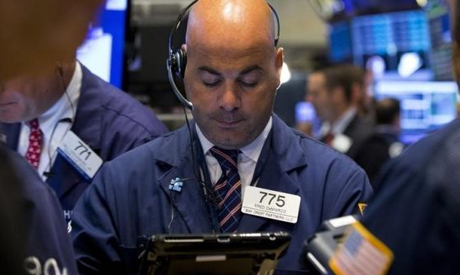
File Photo: Traders work on the floor of the New York Stock Exchange . (Photo: Reuters)
World share markets rose on Wednesday and short-term U.S. bond yields hit 4 1/2-year highs as investors braced for the possibility of the first interest rate hike in the United States in almost a decade.
A late 5 percent surge in Chinese stocks had helped Asia's bourses .MIAPJ0000PUS finish more than 2 percent higher, while gains of 1.0, 0.7 and 1.5 percent for London's FTSE .FTSE, Frankfurt's DAX .GDAXI and Paris's CAC 40 .FCHI meant a solid day for Europe too.
Wall Street, though, was expected to resume marginally in the red ESc1, as markets remained in a state of flux over the likelihood of a rate increase by the Fed at its two-day meeting later on Wednesday.
A key gauge, Fed fund futures <0#FF:>, currently see only a 30 percent chance that Janet Yellen and her colleagues will pull the trigger.
But surveys of economists have been more like 50-50, and rises in U.S. government bond yields US2YT=RR show traders appear to be hedging their bets.
U.S. data published on Tuesday had done little to change expectations and inflation figures due at 1230 GMT are unlikely to sway many opinions either.
"It's more a day for thinking about tomorrow," said Kit Juckes, head of currency strategy at Societe Generale in London.
"Positions are coming off rather than going on. We have seen the front end (short-dated U.S. government bond yields) rally but it hasn't really sent the dollar roaring."
The greenback .DXY was essentially plodding its well-worn range of the last few weeks, though it crept up to $1.1261 EUR= against the euro and 120.50 yen JPY= after revised euro zone inflation came in lower than expected and Japan saw its credit rating cut by S&P.
ROUBLE RALLY
Adding to the recent worries about a deterioration in the health of world economy, the Paris-based Organisation for Economic Cooperation and Development trimmed its global growth forecasts.
It cited primarily a slowdown in emerging market economies like China and Brazil, though it also upped its U.S. projections and urged the Fed to get its first rate hike since the financial crisis over and done with.
"Raising interest rates now would remove uncertainty in the markets," OECD chief economist Catherine Mann told Reuters, adding that what the U.S. central bank did afterwards would matter far more than the initial move.
Emerging market currencies remained under pressure near multi-year lows amid worries that future higher U.S. interest rates could lure away foreign investors again.
However some of those hardest hit in recent months, like Russia's rouble RUB=, Turkey's lira TRY= and Mexico's peso MXN= made gains as traders squared up in case of any Fed surprises.
The rouble was up almost 1.5 percent against the dollar and 1.7 percent against the euro.
It was helped by gains in oil prices for a second day running. Brent climbed more than 1 percent to $48.32 per barrel LCOc1 and U.S. crude hit $45.27 CLc1, after an unexpected crude drawdown reported by the American Petroleum Institute..
Gold XAU= was languishing near one-month lows at $1,107 an ounce, though industrial metals including copper and nickel extended their slight recovery of the last few weeks.
China shares .CSI300 had provided a sentiment boost too as they saw a strong rally in the last hour of trading to end up 5 percent. Hong Kong's Hang Seng index .HSI jumped in tandem to close 2.4 percent higher.
U.S. Treasuries' yields rose again, with the policy-sensitive two-year yield US2YT=RR climbing to 0.8189 percent, its highest level since April 2011.
The 10-year U.S. notes' yield stood at 2.292 percent US10YT=RR having risen to a 1-1/2-month high of 2.294 percent on Tuesday, while yields in benchmark European markets also climbed despite more hints of fresh ECB money printing.
"The total amount that we have purchased represents 5.3 percent of the GDP (gross domestic product) of the euro area, whereas what the Fed has done represents almost 25 percent of the U.S. GDP, what the Bank of Japan has done represents 64 percent of the Japanese GDP and what the UK has done 21 percent of the UK’s GDP," ECB Vice President Vitor Constancio told Reuters in an interview.
"So we are very far from what the major central banks have done," Constancio, 71, said. "This is not a benchmark ... (but) there is scope, if the necessity is there."
Short link: